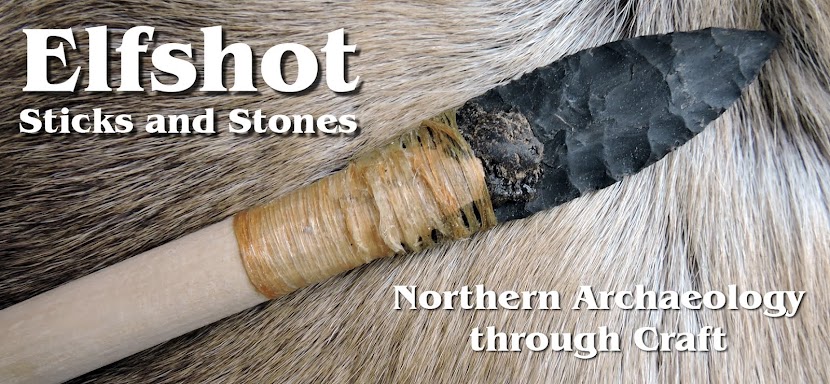 |
| Dorset knife on the tarp |
I did the first
Open Minds flintknapping demonstration of the season yesterday at The Rooms. It was for grade five students who are spending the school week in a classroom in The Rooms, getting a behind the scenes look at the Provincial Art Gallery, Archives, and Museum. For today, I'm going to pretend that no one reads this diary and make a few notes for myself for future demonstrations.
The toughest question that I got was; "Why do you knap on your lap instead of a table?"
 |
| I always work on my lap. |
I don't think I've ever had that question before and the short answer is "Because that's how I was taught." There are knappers who do amazing work using benches or tables as support. It seems especially well suited for pressure and punch knapping. I do want to practice more with punches, so maybe I should try working on benches from time to time. I use small wooden anvils in the workshop that I do punch work on, so maybe I should bring one along to the next demo to show that there are different ways to work stone tools. Just because I'm comfortable working one way doesn't mean that's the way everyone did it in the past.
 |
| I usually use obsidian in classroom demonstrations. Its not local, but its more predictable than the Newfoundland chert that I use when making artifact reproductions. |
The best new addition to the demo is the "Caribou hunt" detachable foreshaft demonstration.
 |
| Interchangeable foreshafts |
I stumbled on this last spring and need to remember to make time for it in each demo because it really gets the kids on board. I have one Maritime Archaic spear shaft and five matching foreshafts with stone points. To demonstrate one reason why people would make composite tools with detachable foreshafts, I tell the kids that they are a caribou herd and I'm a hunter. With one spear and a bag of five foreshafts I can take down many caribou at one time. With the first foreshaft hafted in the spear, I pick a kid/caribou to "stab" - they hold on to the foreshaft and I pull away the main shaft, refit it with another foreshaft and pick another kid/caribou. The most important thing is to slaughter the kids equally, I stabbed a row of boys the first time, and the girls complained it wasn't fair until I stabbed them as well. Once the kids understand that people made complex, composite tools with interchangeable parts many new avenues of discussion open up.
 |
| Lots of reproductions on the tarp help generate discussion during the demonstration. Passing them around keeps kids engaged. |
The wobbliest point is talking about the rocks before the demo starts.
 |
| Reproductions and raw materials |
I need to talk about the rocks a bit to set things up, but kids don't really get drawn in until the first flake gets knocked off with the hammerstone. Maybe I need to do that right away, right after "Hello, my name is..." crack off a big flake and then talk about rocks and what the demo is going to be about. That would probably get their attention earlier and hold it longer.
 |
| The best advice I ever received on giving flintknapping demos was not to expect to do your best work. Save that for your workshop and bring those examples along, but in a demonstration, its ok to lower your expectations. You don't have the time to set-up every platform and plan every flake like you do at home, so don't expect the same results. |
Photo Credits:
1,2,4-7: Tim Rast
3: Michael Burzynski


















































